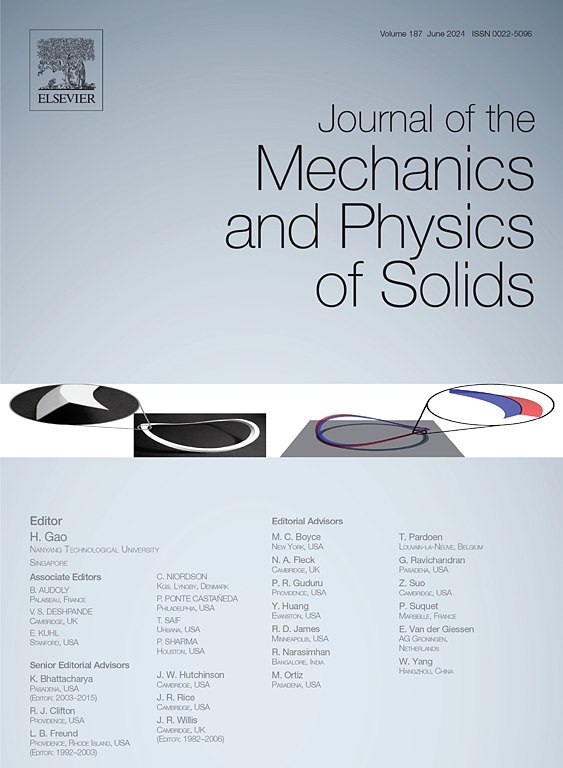Fluid effects on the fracture toughness of gels
IF 5
2区 工程技术
Q2 MATERIALS SCIENCE, MULTIDISCIPLINARY
引用次数: 0
Abstract
The fracture of polymeric gels has been of growing interest in the last two decades. Well established continuum theories that couple large deformations and fluid diffusion have been applied to gels to determine crack tip fields and the energy release rate. Some studies have combined experiment and calculations to determine the fracture toughness of gels and have shown that fluid effects make a substantial contribution to the toughness. Here we adopt a micro-mechanical view to estimate the fracture toughness of gels, defined as the critical (total) energy release rate, and show how the initiation toughness can be written as a combination of contributions from fiber scission and of fluid–solid demixing at the crack tip. This estimate is based on knowledge of a critical stretch and an associated volumetric strain when fracture is incipient and reveals dependencies on material properties including the solid volume fraction of gels. There have been no known ways to measure the de-mixing contribution directly from experiments, but the results in this paper provide a methodology. We also show how dissipation due to fluid motion as the crack propagates can contribute to the fracture toughness. Detailed results are presented for fibrin gels, which are the main structural component of blood clots.
流体对凝胶断裂韧性的影响
在过去的二十年里,聚合物凝胶的断裂一直受到越来越多的关注。将大变形和流体扩散相结合的连续介质理论应用于凝胶中,确定了裂纹尖端场和能量释放率。一些研究将实验和计算相结合来确定凝胶的断裂韧性,并表明流体效应对韧性有很大的贡献。在这里,我们采用微观力学的观点来估计凝胶的断裂韧性,定义为临界(总)能量释放率,并展示了如何将起裂韧性写成纤维断裂和裂纹尖端流固分离的综合贡献。这一估计是基于对断裂初期临界拉伸和相关体积应变的了解,并揭示了包括凝胶固体体积分数在内的材料特性的依赖性。目前还没有已知的方法可以直接从实验中测量脱混的贡献,但本文的结果提供了一种方法。我们还展示了裂纹扩展过程中流体运动的耗散如何影响断裂韧性。详细的结果提出了纤维蛋白凝胶,这是血凝块的主要结构成分。
本文章由计算机程序翻译,如有差异,请以英文原文为准。
求助全文
约1分钟内获得全文
求助全文
来源期刊
CiteScore
9.80
自引率
9.40%
发文量
276
审稿时长
52 days
期刊介绍:
The aim of Journal of The Mechanics and Physics of Solids is to publish research of the highest quality and of lasting significance on the mechanics of solids. The scope is broad, from fundamental concepts in mechanics to the analysis of novel phenomena and applications. Solids are interpreted broadly to include both hard and soft materials as well as natural and synthetic structures. The approach can be theoretical, experimental or computational.This research activity sits within engineering science and the allied areas of applied mathematics, materials science, bio-mechanics, applied physics, and geophysics.
The Journal was founded in 1952 by Rodney Hill, who was its Editor-in-Chief until 1968. The topics of interest to the Journal evolve with developments in the subject but its basic ethos remains the same: to publish research of the highest quality relating to the mechanics of solids. Thus, emphasis is placed on the development of fundamental concepts of mechanics and novel applications of these concepts based on theoretical, experimental or computational approaches, drawing upon the various branches of engineering science and the allied areas within applied mathematics, materials science, structural engineering, applied physics, and geophysics.
The main purpose of the Journal is to foster scientific understanding of the processes of deformation and mechanical failure of all solid materials, both technological and natural, and the connections between these processes and their underlying physical mechanisms. In this sense, the content of the Journal should reflect the current state of the discipline in analysis, experimental observation, and numerical simulation. In the interest of achieving this goal, authors are encouraged to consider the significance of their contributions for the field of mechanics and the implications of their results, in addition to describing the details of their work.

 求助内容:
求助内容: 应助结果提醒方式:
应助结果提醒方式:


